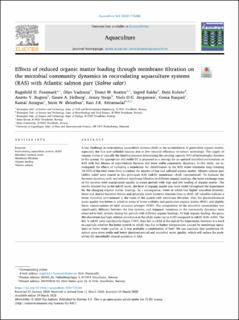| dc.contributor.author | Fossmark, Ragnhild Olsen | |
| dc.contributor.author | Vadstein, Olav | |
| dc.contributor.author | Rosten, Trond Waldemar | |
| dc.contributor.author | Bakke, Ingrid | |
| dc.contributor.author | Koseto, Deni | |
| dc.contributor.author | Bugten, Anette Voll | |
| dc.contributor.author | Helberg, Gaute Alexander Nedberg | |
| dc.contributor.author | Nesje, Jenny | |
| dc.contributor.author | Jørgensen, Niels O.G. | |
| dc.contributor.author | Raspati, Gema Sakti | |
| dc.contributor.author | Azrague, Kamal | |
| dc.contributor.author | Østerhus, Stein Wold | |
| dc.contributor.author | Attramadal, Kari | |
| dc.date.accessioned | 2020-05-07T08:13:53Z | |
| dc.date.available | 2020-05-07T08:13:53Z | |
| dc.date.created | 2020-04-07T08:31:01Z | |
| dc.date.issued | 2020-07-15 | |
| dc.identifier.issn | 0044-8486 | |
| dc.identifier.uri | https://hdl.handle.net/11250/2653575 | |
| dc.description.abstract | A key challenge in recirculating aquaculture systems (RAS) is the accumulation of particulate organic matter, especially the fine and colloidal fraction due to low removal efficiency of today's technology. The supply of organic matter is typically the limiting resource determining the carrying capacity (CC) of heterotrophic bacteria in the system. An appropriate and stable CC is proposed as a strategy for an optimal microbial environment in RAS with less blooms of opportunistic bacteria and more stable community dynamics. In this study, we investigated the effects of including a membrane for ultrafiltration in the RAS water treatment loop (treating 10–15% of the total water flow) to reduce the amount of fine and colloidal organic matter. Atlantic salmon parr (Salmo salar) were reared in two pilot-scale RAS (mRAS: membrane, cRAS: conventional). To evaluate the bacterial dynamics with and without membrane filtration at different organic loadings, the water exchange rates of the systems were manipulated equally to create periods with high and low loading of organic matter. The results showed that in the mRAS water, the level of organic matter was more stable throughout the experiment for the changing organic matter loadings. As a consequence, water in mRAS had higher microbial diversity, lower and shorter bacterial blooms and generally lower bacterial densities than in cRAS. All variables indicate a better microbial environment in the water of the system with membrane filtration. Also, the physicochemical water quality was better in mRAS in terms of lower turbidity and particulate organic matter (POC), and slightly lower concentrations of total ammonia nitrogen (TAN). The composition of the microbial communities was significantly different between the two systems, and temporal variations in the community dynamics were observed in both systems during the periods with different organic loadings. At high organic loading, the genus Mycobacterium had high relative abundance in the cRAS water (up to 0.25) compared to mRAS (0.01–0.03). The fish in mRAS were significantly bigger (14%) than fish in cRAS at the end of the experiment, however it is hard to conclude whether the better growth in mRAS was due to higher temperatures (caused by membrane operation) or better water quality, as it was probably a combination of both. We can conclude that membrane filtration gave more stable and better physicochemical and microbial water quality, which will reduce the probability for microbially related accidents in RAS. | en_US |
| dc.language.iso | eng | en_US |
| dc.publisher | Elsevier Ltd | en_US |
| dc.rights | Navngivelse 4.0 Internasjonal | * |
| dc.rights.uri | http://creativecommons.org/licenses/by/4.0/deed.no | * |
| dc.subject | Recirculating aquaculture systems (RAS) | en_US |
| dc.subject | Microbial matured water | en_US |
| dc.subject | Membrane filtration | en_US |
| dc.subject | Organic loading | en_US |
| dc.subject | Atlantic salmon | en_US |
| dc.title | Effects of reduced organic matter loading through membrane filtration on the microbial community dynamics in recirculating aquaculture systems (RAS) with Atlantic salmon parr (Salmo salar) | en_US |
| dc.type | Journal article | en_US |
| dc.type | Peer reviewed | en_US |
| dc.description.version | publishedVersion | en_US |
| dc.rights.holder | 0044-8486/ © 2020 The Authors. Published by Elsevier B.V. This is an open access article under the CC BY license | en_US |
| dc.source.volume | 524 | en_US |
| dc.source.journal | Aquaculture | en_US |
| dc.identifier.doi | 10.1016/j.aquaculture.2020.735268 | |
| dc.identifier.cristin | 1805500 | |
| dc.relation.project | SINTEF Ocean: 702296 | en_US |
| dc.relation.project | Norges forskningsråd: 260872 | en_US |
| cristin.ispublished | true | |
| cristin.fulltext | original | |
| cristin.fulltext | original | |
| cristin.qualitycode | 1 | |

